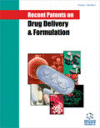- Home
- A-Z Publications
- Recent Patents on Drug Delivery & Formulation
- Previous Issues
- Volume 1, Issue 3, 2007
Recent Patents on Drug Delivery & Formulation - Volume 1, Issue 3, 2007
Volume 1, Issue 3, 2007
-
-
Liposomal Drug Delivery: Recent Patents and Emerging Opportunities
More LessAuthors: Murray S. Webb, Patrick Rebstein, Wendy Lamson and Marcel B. BallyIt is challenging to develop innovative, as well as commercially viable, lipid-based drug delivery systems for the treatment of cancer because of the breadth of existing intellectual property that limits freedom-to-operate. For example, novel compositions can be described in which a new chemical entity is associated with a lipid based carrier, but if the loading method or components of the lipid compositions are proprietary then the Read More
-
-
-
Microstructured Devices for Transdermal Drug Delivery and Minimally-Invasive Patient Monitoring
More LessAuthors: Ryan F. Donnelly, Anthony Morrissey, Paul A. McCarron and David A. WoolfsonTransdermal drug delivery offers certain advantages over conventional oral or parenteral administration. However, the excellent barrier function of the skin, accomplished almost entirely by the stratum corneum, restricts the number of drug substances that can be administered transdermally to those with very specific physicochemical properties. Several approaches have been used to enhance the transport of drugs through the Read More
-
-
-
New Aspects in Sustained Drug Release Formulations
More LessAuthors: Dimitrios Bikiaris, Efthimios Koutris and Evangelos KaravasNowadays, pharmaceutical technology and research for new drugs and formulations is of great importance, as scientists attempt to discover even more revolutionary and efficient methods to treat various diseases. At the same time the correct dosing and site targeting are equally important for clinical success. Research in sustained drug release systems is very promising towards such a direction, while it offers advantages an Read More
-
-
-
Recent Advances in Drug Delivery: Potential and Limitations of Carbon Nanotubes
More LessAuthors: Satya Prakash and Arun G. KulamarvaOutstanding progress has been made in drug delivery approaches. However, challenges still exist in delivering clinically optimal levels of therapeutic molecules. Advances in nanotechnology and nanomedicine have heralded the advent of several innovative nanomaterials which are set to revolutionize the field of drug delivery. Carbon nanotubes are one such novel class of nanomaterials that are gaining increasing attent Read More
-
-
-
Recent Approaches for Colon Drug Delivery
More LessAuthors: Gurpreet Kaur, Subheet Jain and Ashok K. TiwaryColon delivery is especially required for drugs intended to act locally or for drugs that exhibit maximum systemic absorption from the colon. However, exposure to extreme pH conditions, gastric enzymes, bile salts and variation in gastric emptying makes the development of colon release dosage forms extremely challenging. The approaches generally used for formulating a colon release dosage form include use of pH dep Read More
-
-
-
Recent Developments in Oral Bait Vaccines for Wildlife
More LessAuthors: Cristina Ballesteros, Jose M. Perez de la Lastra and Jose de la FuenteThe vaccination of wildlife reservoirs of infection is important for effective disease control programs and usually requires the use of oral vaccines. Current inventions in the field of oral baits for the immunization of wildlife cover effective vaccine compositions, vaccine containers to deliver the vaccine orally to target species, and baits that specifically attract the target species. Oral bait vaccine formulations need to provide an e Read More
-
-
-
An Overview of Recent Patents on Oral Osmotic Drug Delivery Systems
More LessAuthors: Pramod Kumar and Brahmeshwar MishraIn recent years, novel drug delivery systems (NDDS) have been recognized as an attractive niche for the pharmaceutical and health industry. Among various NDDS, osmotic drug delivery systems (ODDS) are most interesting and widely applicable. Osmotic drug delivery system use osmotic pressure for controlled delivery of active agent(s). Drug delivery from these systems, to a large extent is independent of the physiologic Read More
-
Most Read This Month
Article
content/journals/ddf
Journal
10
5
false
en


